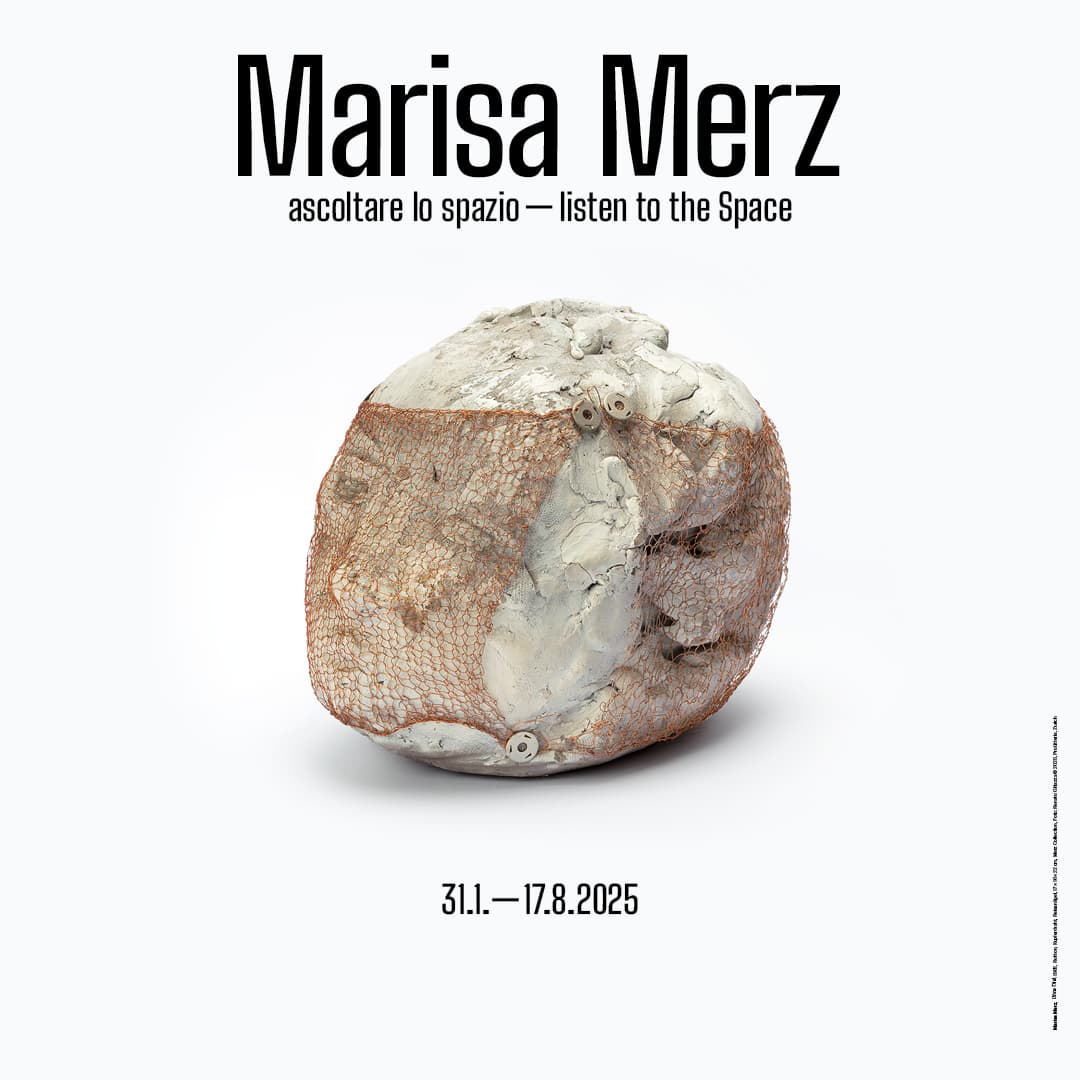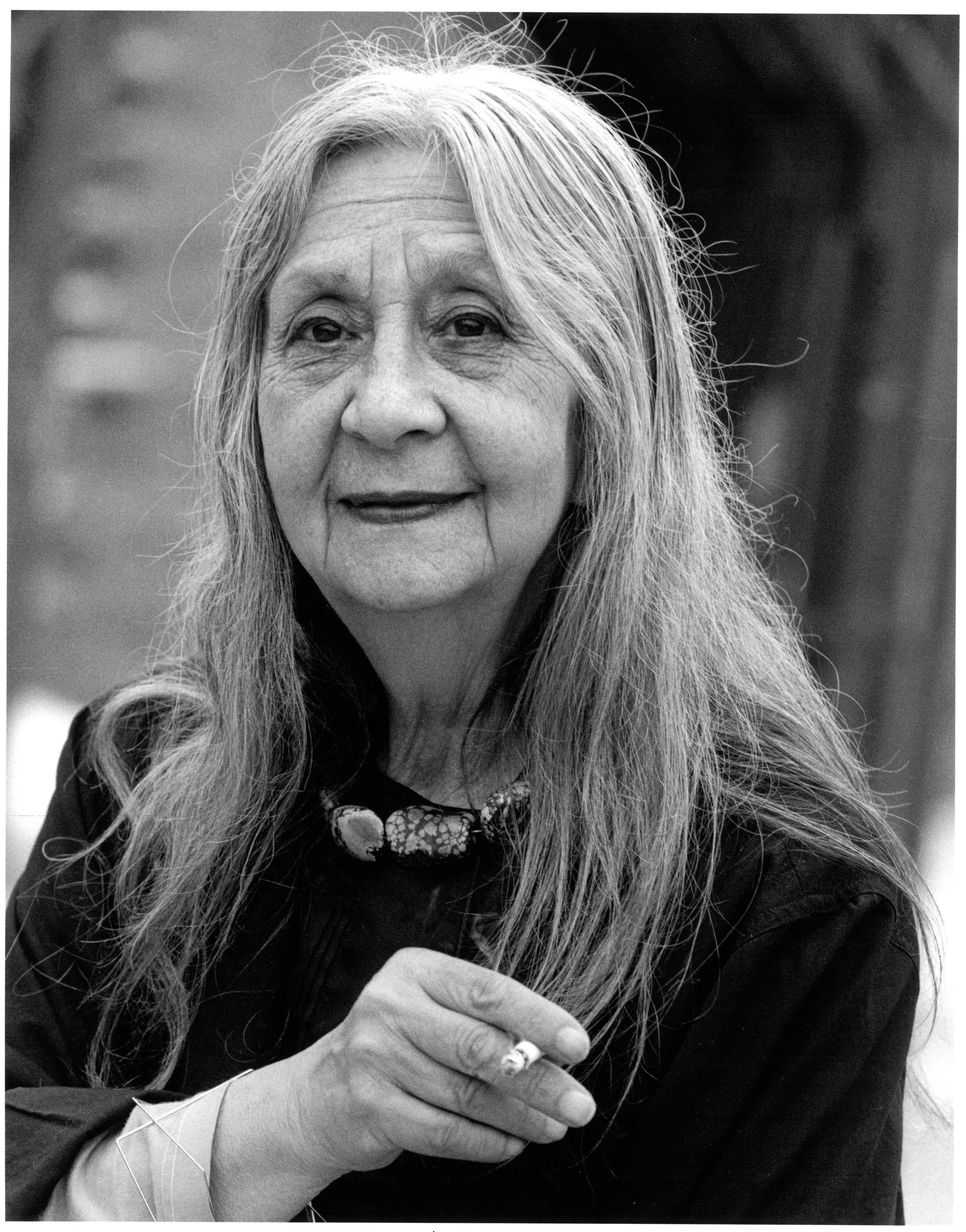
Note: Works are placed on the floor in the exhibition. Please respect the safety lines.
Introduction
Kunstmuseum Bern is showing the largest retrospective of the Italian artist Marisa Merz (1926−2019) to take place in Switzerland in more than thirty years. The artist was honoured at the 55th Venice Biennale in 2013, receiving a Golden Lion for her life’s work. Today, she is considered to be the only woman among the major representatives of Arte Povera. She was active both centrally and on the margins of the radical art movement, which developed during the late 1960s in a post-industrial and turbulent Italy, where she succeeded in producing a unique body of work.
The subtle power of Marisa Merz’s work is reflected in a vision originating from within. She believed that ‘the eye guides the hand’. She also stated that even ‘when the eyes are closed, they are extraordinarily open’. Her work is characterized by silence, poetry and a search for the fragility of art that, according to the artist, corresponded to that of life. Merz refused to title or date her works because she regarded them as being in constant flux. She returned again and again to the same motifs, materials and techniques in order to arrive as closely as possible at their essence. She explored her subject matter using subtle and ongoing variations leading from one work to the next. Marisa Merz viewed painting as a language endowed with a memory. She was inspired by the European history of painting, while creating a history of art that was entirely her own.
In her studio, she transformed space and time into a large-scale collage using drawings, paintings, sculptures and objets trouvés. The artist moved in a virtuoso manner between art history and the everyday, employing a variety of everyday objects and materials such as aluminium, clay, copper, nylon, wax and fabric. Marisa Merz’s use of differing materials is nuanced and radically personal, while inseparably linking high and popular culture.
The exhibition is a cooperation with the LaM – Lille Métropole, musée d’art moderne, d’art contemporain et d’art brut and the Fondazione Merz.
Silence and Movement
È Tutto così fermo
e in quel momento si muove
la foglia
Everything is so still
and in that instant the leaf
moves
(Marisa Merz)
Marisa Merz has been involved in Turin’s cultural scene since her late teens. In theater, dance and painting she encountered a world of great historical and artistic richness. That inventiveness can be seen in the many faces she has modeled or drawn since the 1970s. By constantly modelling her heads, with ‘as much − or as little − material as her hands could hold’, Merz seeks to capture the essence of the portrait. Beyond the threshold of resemblance, she attempted to approach the truth of the subject. With her heads, she confronts the difficulty of capturing reality as it is: elusive, in constant transformation.
Merz made a habit of transforming her works over the course of time and exhibitions, in relation to the space she occupied and making her installations in situ environments. This also applies to her works made of copper wire. The artist adapted the woven triangles to the available space and created her own rhythms and intermissions on the wall.
Profane Spaces
non corrisponde eppur fiorisce
it doesn’t match, yet it flourishes
(Marisa Merz)
Marisa Merz knew that art and life could not be separated from one another. ‘There was never a separation between my work and my life’, is one of the most famous quotes, taken from one of her rare interviews in 1975. The statement refers both to her career and life as a woman in post-war Italy. Despite political and social progress, the traditional role models and the belief in male superiority still prevailed. There is something political about the constant investigation of her everyday life, which accords with the feminist dictum of the time that the private is political.
During the 1960s, Merz worked privately in seclusion. She made works of art based on her own body measurements and created toys for her daughter Beatrice, born in 1960 in Switzerland. The artist transformed mundane, humble materials such as aluminium foil and nylon thread and techniques such as sewing and knitting into art. By integrating everyday materials and her own corporeal experiences into her work as an artist, Merz was able to subtly criticise society. Such works as Scarpetta (‘Little Shoe’), Coperta (Blanket) or Bea create a relation to space and intervene in it. In the interview mentioned above, the artist explained: ‘I have never made an exhibition actually using my body. But I noticed that when I visited an exhibition to which I was not invited as an artist, I didn’t feel like I wasn’t part of it; I went there and said: it’s me’.
In the Realm Between
La stanza del mare
La stanza del vuoto
La stanza della fame
La stanza dell’arcobaleno
The room of the sea
The room of emptiness
The room of hunger
The rainbow room
(Marisa Merz)
Marisa Merz devised her work in close relation to the space. The artist with the ‘absolute eye’ was known for reconceiving her works at each exhibition. She did so by rearranging her pieces, allowing drawings to grow into the space or assembling sculptures into large-scale installations. She combined ‘poor’ – simple and quotidian – objects or materials, celebrating the moment when ‘something’ emerged. Merz was guided by the ‘intelligence inherent to matter’, completely relying on the autonomous presence of clay, graphite, wax, gold leaf, copper wire, wood and paper. These notions of sculpture as a process and generator of energy resonate with the radical approaches of other such artists as Robert Morris and Eva Hesse.
The type of transformation she was able to engender in objects and materials through their combination and treatment created an aura evoking religious or spiritual practices. From her Living Sculptures to her copper wire installations, Merz not only explored sculpture’s traditional forms and techniques, but also employed works in ritually demarking her personal space. The works of art simultaneously protect and extend her private world. The beings that Merz enables to emerge in her drawings and paintings also alternate between the human and non-human, between presence and absence. They belong to both the visible and the spiritual world.
Sacred Spaces
l'occhio guida la mano
(l'occhio è l’angelo?)
the eye guides the hand
(is the eye the angel?)
(Marisa Merz)
The motifs, colours and composition of Marisa Merz’s works frequently echo the works of art of past eras: from Byzantine icons to the religious paintings of Fra Angelico and Antonello da Messina as well as Flemish painting of the early Renaissance. In addition to obvious references, more subtle but no less significant allusions to religious and spiritual subject matter are likewise evident in her work. This is enabled, to an extent, by her rendering of religious symbols and narratives, but is mainly due to the way the artist addresses the body, space and the relationship between the human and superhuman.
It is said of Merz that she created exhibitions that were works of art in themselves. She had the ability to transcend the visible, to transform physical spaces into spiritual ones: places of retreat, introspection and encounters with the self – or with the invisible.
The Sky is a Great Space
Parlami di Antonello da Messina
Parlami di Gentile da Fabriano
Parlami dell’agnello mistico
Parlami che il cielo è grande spazio
Tell me about Antonello da Messina
Tell me about Gentile da Fabriano
Tell me about the Lamb of God
Tell me that the sky is a great space
(Marisa Merz)
From the 2000s onwards, Marisa Merz spent ever more time in her studio, proceeding in her dialogue with the great masters of the Renaissance. She increasingly produced drawings and paintings of figures with wings that seem reminiscent of imagery in sacred art: Madonnas, angels and other heavenly creatures.
Merz also explored new possibilities in the area of drawing. By combining large sheets of paper, she was able to exceed their physical limits, creating imagery that could be situated in the tradition of Italian fresco painting. The large-format drawings rapidly filled the walls of her studio. Sometimes they also contained components form other works, such as small modeled heads or copper wires. Merz tirelessly followed the properties of the materials and the spaces. She continually created new forms in new contexts. Nature and time assisted in shaping her works. Using ‘poor’ – simple and quotidian – materials and techniques, she created poetic works that draw the viewer in. Even during her late period, her work remains complex and extremely open, enabling a wide range of ways of approaching and interpretating it.
Biography

Marisa Merz was born on 23 May 1926 in Turin. As a teenager, she developed an interest in the rich culture of her hometown. She began her career in the 1960s with the Living Sculptures, works fashioned from aluminium foil. Her deep research into materials was closely linked to the Arte Povera movement that was emerging in the late 1960s in northern Italy. Together with her husband, Mario Merz, she is considered one of the main representatives of this avant-garde movement. In 1960, the couple lived and worked for a period in Switzerland, where their daughter Beatrice was born.
From the mid-1970s, Merz’s sculptures and installations communicated with the spaces they occupied, changing along with them. Concurrently, her interest in the human face began, which she explored by employing a wide range of materials and techniques until her death in Turin on 19 July 2019.
Merz participated in numerous group exhibitions, including Identité italienne. L’art en Italie depuis 1959 (Centre Pompidou, Paris, 1981), Avanguardia. Transavanguardia (Palazzo delle Esposizioni, Rome, 1982) as well as several times in documenta in Kassel and the Biennale in Venice, where in 2013 she won the Golden Lion. She was recently included in the exhibition Arte Povera (Bourse de Commerce Pinault Collection, Paris, 2024). Her work has been recognized with solo exhibitions at international institutions such as Kunstmuseum Winterthur (1994), Centre Pompidou in Paris (1994), Stedelijk Museum in Amsterdam (1996), the Metropolitan Museum of Art in New York (2017), the Hammer Museum in Los Angeles (2017) and Museum der Moderne in Salzburg (2018).
Imprint
Marisa Merz. Ascoltare lo spazio / Listen to the Space
Kunstmuseum Bern
31.1.–17.8.2025
Curator: Livia Wermuth
The exhibition is a cooperation with the LaM − Lille Métropole, musée d'art moderne, d'art contemporain et d'art brut and the Fondazione Merz.
Exhibition catalogue: Marisa Merz. Ascoltare lo spazio / Écouter l'espace, edited by Sébastien Delot, Grégoire Prangé, Fonds Mercator, Brussels 2024.
Exhibition design: Salzmann Gertsch
Digital Guide:
Implementation: NETNODE AG
Project: Andriu Deflorin, Cédric Zubler
With the support of




Media partner

Kunstmuseum Bern
Hodlerstrasse 8–12, 3011 Bern
+41 31 328 09 44
info@kunstmuseumbern.ch
kunstmuseumbern.ch/MarisaMerz










